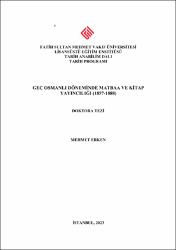| dc.contributor.advisor | Göleç, Mustafa | |
| dc.contributor.author | Erken, Mehmet | |
| dc.date.accessioned | 2024-03-04T14:02:59Z | |
| dc.date.available | 2024-03-04T14:02:59Z | |
| dc.date.issued | 2023 | en_US |
| dc.identifier.citation | ERKEN, Mehmet, Geç Osmanlı Döneminde Matbaa ve Kitap Yayıncılığı (1857-1888), Fatih Sultan Mehmet Vakıf Üniversitesi Lisansüstü Eğitim Enstitüsü Tarih Anabilim Dalı Tarih Programı, Yayımlanmamış Doktora Tezi, İstanbul 2023. | en_US |
| dc.identifier.uri | https://hdl.handle.net/11352/4727 | |
| dc.description.abstract | Bu tez, özel matbaaların açılmasına izin veren ve 1857 yılında yayınlanan
matbaalar nizamnaâmesinden 1888 yılında yayınlanan ikinci matbaalar
nizamnâmesine kadar Osmanlı’da kitabın üretim ve satış aşamalarındaki değişimi ele
almaktadır. Özel matbaalara izin verilmesinin ardından hızla yaygınlaşan ve faaliyet
alanı genişleyen matbaacılık sektörü, yeni hukuki düzenlemeler, yeni makinelerin ve
malzemelerin ithali ve matbaa eğitiminin gelişimi gibi çok yönlü değişimler tecrübe
etmiştir. Osmanlı eğitim sistemi ve ticari hayatında da köklü bir değişimin yaşandığı
bu dönemde, kitaplar sadece İstanbul’da değil, ülke çapında yaygınlık kazanmaya
başlamıştır. Bütün bu gelişmeler neticesinde, 1880’li yıllarda, yayınevleri, bir kitabın
yazarından çıkıp okuruna ulaşana kadar geçirdiği evreler arasında bir aracı olarak
temayüz etmiştir. Robert Darnton’un kitap tarihi incelemelerine dair geliştirdiği
çerçeve, bu çalışmada Osmanlı özelinde yeniden ele alınarak kullanılmıştır. Bu
çerçeve içinde bir kitabın yazarın elinden çıkıp okura ulaşana kadar geçirdiği
aşamalara etki eden matbaa makineleri, matbaa çalışanları, hukuki müeyyideler,
matbaacılık piyasası ve kitap üreten aktörler ele alınmış; yazarlar ve okurlar
araştırmanın kapsamı dışında bırakılmıştır. | en_US |
| dc.description.abstract | This dissertation focuses on the change in the production and sales of books in
the Ottoman State between the 1857 regulations of printing, which allowed the
establishment of private printing houses, and the following printing regulations in
1888. The printing industry, which rapidly became widespread and expanded after
private printing houses were allowed, has experienced multifaceted changes such as
new legal regulations, the import of new machinery and materials, and the
development of printing education. This period also witnessed a radical shift in the
Ottoman education organization and commercial life. Accordingly, books became
widespread not only in Istanbul but throughout the country. As a result, publishing
houses emerged as a mediator between the author and the reader in the 1880s. This
study borrows the framework developed by Robert Darnton on book history by
reconsidering it specifically for the Ottoman context. Within this framework, leading
factors affecting the stages of a book between the author and the reader such as printing
machines, printing press workers, legal sanctions, the printing market, and actors that
produce books are discussed, excluding the authors and readers from the scope of the
study. | en_US |
| dc.language.iso | tur | en_US |
| dc.publisher | Fatih Sultan Mehmet Vakıf Üniversitesi | en_US |
| dc.rights | info:eu-repo/semantics/openAccess | en_US |
| dc.subject | Matbaacılık | en_US |
| dc.subject | Yayıncılık | en_US |
| dc.subject | Kitapçılık | en_US |
| dc.subject | Kitap Tarihi | en_US |
| dc.subject | Sosyal Tarih | en_US |
| dc.subject | Printing | en_US |
| dc.subject | Publishing | en_US |
| dc.subject | Bookselling | en_US |
| dc.subject | Book History | en_US |
| dc.subject | Social History | en_US |
| dc.title | Geç Osmanlı Döneminde Matbaa ve Kitap Yayıncılığı (1857-1888) | en_US |
| dc.title.alternative | Printing And Publishing in the Late Ottoman Period (1857-1888) | en_US |
| dc.type | doctoralThesis | en_US |
| dc.contributor.department | FSM Vakıf Üniversitesi, Lisansüstü Eğitim Enstitüsü, Tarih Ana Bilim Dalı | en_US |
| dc.relation.publicationcategory | Tez | en_US |
| dc.contributor.institutionauthor | Erken, Mehmet | |



















